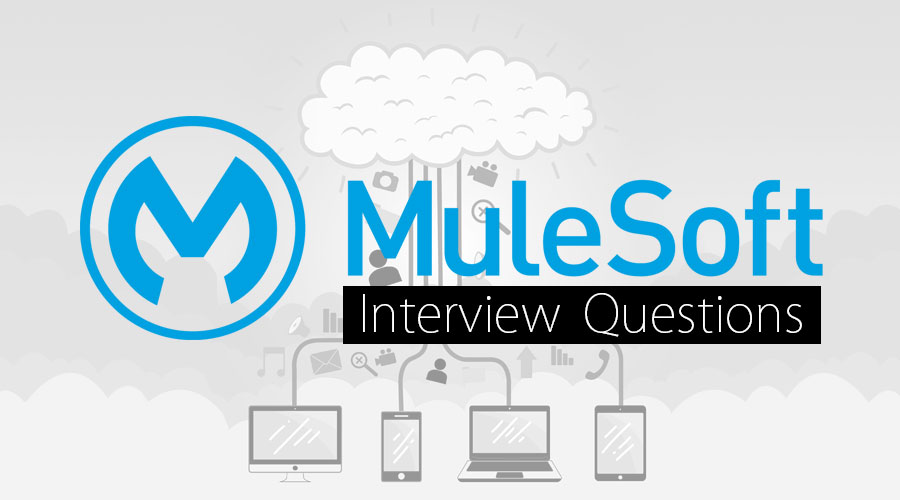Updated June 9, 2023

Introduction to Mulesoft Interview Questions And Answers
MuleSoft is the most widely used integration platform. Its the Integration Mule ESB and Cloud Hub. It helps in connecting Enterprise and SAAS applications in the cloud and on-premise. Mule ESB is a Java-based ESB(enterprise service bus). Mulesoft integration platform helps a developer to connect to their application with ESB. It is a lightweight integration framework. ESB is highly scalable, which means it helps connect the small application with multiple applications, but ESB Will did not fit for all the projects to implement. If we want to use ESB, the deep analysis should be done by considering all the parameters.
So if you are looking for a job that is related to Mulesoft, you need to prepare for the 2023 MuleSoft Interview questions. Though every interview is different and the job scope is also different, we can help you out with the top Mulesoft Interview questions and answers, which will help you take the leap and get your success in an interview.
Below is the Mulesoft Interview Questions that are mostly asked in an interview. This set of question is divided into two parts which are as follows:
Part 1 – Mulesoft Interview Questions (Basic)
This first part covers basic Mulesoft Interview Questions and answers.
1. What is Mulesoft? For what Mulesoft is used for?
Answer:
MuleSoft is the most widely used integration platform. We will find 2 types Mule ESB and Cloud Hub, for connecting enterprise and SAAS applications in the on-premises and cloud. Mulesoft allows developers to connect applications together quickly and easily, and it helps in exchanging the data.
2. Explain the types of variables in mule?
Answer:
There are 3 types of variables available in a mule.
- Flow Variable
- Session Variable
- Record Variable
3. What is Mule ESB?
Answer:
Mule ESB is a Java-based ESB (enterprise service bus), and it is the integration platform all the developers can connect to their respective application directly with ESB. Mule ESB uses service-oriented architecture. The main use of Mule ESB is it enables easy integration of existing systems. It can integrate with different technologies that the applications use- Including JMS, Web Services, HTTP, etc.
Let us move to the next Mulesoft Interview Questions.
4. What is ESB?
Answer:
ESB stands for Enterprise Storage bus. It’s a software architecture for middleware, and it provides fundamental services for more complex architectures. These are the common Mulesoft Interview Questions that are frequently asked in an interview.
Example: In ESB incorporates with the features required to implement an SOA(service-oriented architecture ).
5. What is the MuleSoft Anypoint platform, and where it will be used?
Answer:
MuleSoft Anypoint Platform of integration products is designed to tie both software as a service (SaaS) and on-premises software.
Part 2 – Mulesoft Interview Questions (Advanced)
Let us now have a look at the advanced Mulesoft Interview Questions.
6. What are the main features of Mule ESB? What are the different ESBs in the market?
Answer:
1)The main Features of Mule ESB are::
- It is a very simple and easy to use-Drag and drops Graphical design.
- SLA monitoring and API management
- High scalability
- We can deploy in a One-click cloud or on-premise deployments
2)Different ESB’s in the Market are::
- Talend
- Mule ESB
- JBoss Fuse ESB
7. How will we identify ESB is needed in a project?
Answer:
Implementation of ESB is not suitable for all the projects. We should analyze is really ESB is required here or not. You need to analyze by considering the below points:
- The project requires 3 or more applications and services to be integrated, and there must be a need to communicate between the applications.
- If it is plain of interacting with more applications and Services in the future, then we can go with Mule ESB because it is highly scalable.
- We need to keep the cost also in mind before going to ESB implementation.
Let us move to the next Mulesoft Interview Questions.
8. Explain the difference between Callout and Service Invoke?
Answer:
Callout: We can call the service using callout or with service invoke. Use the Callout if we need to mediate a message (without calling an intermediate service) and then call a service provider.
- The Callout provides the simplest model for this configuration.
Service Invoke: You need to interact with multiple services and produce an output that combines service responses. The Service Invoke primitive does not switch from request flow to response flow. - Use the Service invoke if we need to call an intermediate service.
Example: We can use an intermediate service to adjust a message or to validate a message externally. The mediation flow contains the Service Invoke mediation primitive and a Callout node that is connected to the service provider; there will be no intermediate service.
9. What is the full form of SDO and SMO?
Answer:
- SDO: Service Data Object, and it represents the Object.
- SMO: Service Message object and it is used to represent messages
10. Explain about Fan-in and Fan-out?
Answer:
Fan-In: Fan-In is always in the flow with Fan-Out and helps in deciding to continue flow execution. The Fan In may only be used in combination with Fan-Out.
Fan-out: We can use the Fan Out-primitive to fire the output terminal once with the input message or to fire the output terminal multiple times. Fan-out can be used as a combination of Fan-Out and Fan In.
Recommended Articles
This has been a guide to the List Of Mulesoft Interview Questions and Answers. Here we have listed the most useful 10 interview sets of questions so that the jobseeker can crack the interview with ease. You may also look at the following articles to learn more –
